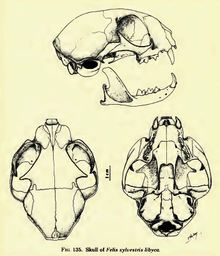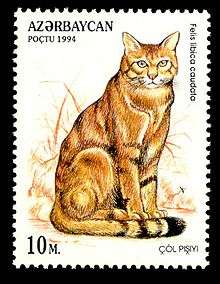African wildcat
| African wildcat | |
|---|---|
 | |
| Scientific classification | |
| Kingdom: | Animalia |
| Phylum: | Chordata |
| Clade: | Synapsida |
| Class: | Mammalia |
| Order: | Carnivora |
| Suborder: | Feliformia |
| Family: | Felidae |
| Genus: | Felis |
| Species: | F. silvestris |
| Subspecies: | F. s. lybica |
| Trinomial name | |
| Felis silvestris lybica (Forster), 1780 | |
The African wildcat (Felis silvestris lybica), also called Near Eastern wildcat is a wildcat subspecies that lives in Northern Africa, the Near East and around the periphery of the Arabian Peninsula.[1][2] The status Least Concern on the IUCN Red List is attributed to the species, including all subspecies of wildcats.[3]
The African wildcat appears to have diverged from the other subspecies about 131,000 years ago. Some individual African wildcats were first domesticated about 10,000 years ago in the Middle East, and are the ancestors of the domestic cat.[2] Remains of domesticated cats were found in human burials in Cyprus that are estimated to have been established by Neolithic farmers about 9,500 years ago.[4] Crossings between domestic cats and African wildcats are still common today.[5]
Characteristics

The fur colour of the African wildcat is light sandy grey, and sometimes with a pale yellow or reddish hue. The ears are reddish to grey, with long light yellow hairs around the pinna. The stripes around the face are dark ochre to black: two run horizontally on the cheek, and four to six across the throat. A dark stripe runs along the back, the flanks are lighter, and the belly is whitish. Pale vertical stripes on the sides often dissolve into spots. Two dark rings are on the forelegs, and hind legs are striped. The feet are dark brown to black.[6]
Pocock described the African wildcat as differing from the European wildcat by inconspicuous stripes on the nape and shoulders, a less sharply defined stripe on the spinal area and by the slender tail, which is cylindrical, less bushy and more tapering. Ears are normally tipped with a small tuft.[7]
Skins of male wildcats from Northern Africa measured 47–59.7 cm (18.5–23.5 in) in head-to-body length with a 26.7–36.8 cm (10.5–14.5 in) long tail. Skins of female wildcats measured 40.6–55.8 cm (16.0–22.0 in) with a 24.1–33.7 cm (9.5–13.3 in) long tail.[8] Male wildcats from Yemen measured 46–57 cm (18–22 in) in head-to-body length with a 25–32 cm (9.8–12.6 in) long tail; females were slightly smaller measuring 50–51 cm (20–20 in) in head-to-body length with a 25–28 cm (9.8–11.0 in) long tail. Both females and males ranged in weight from 3.2 to 4.5 kg (7.1 to 9.9 lb).[9]
Its fur is shorter than that of the European wildcat, and it is considerably smaller.
Distribution and habitat
The African wildcat occurs across northern Africa, in the Near East, around the periphery of the Arabian Peninsula to the Caspian Sea.[2] In Africa, it ranges from Morocco into Egypt, and inhabits the savannas of West Africa from Mauritania to the Horn of Africa, including Somalia, Eritrea, Ethiopia, Djibouti and Sudan, southwards to South Africa. It inhabits a broad variety of habitats, especially in hilly and mountainous landscapes such as the Hoggar Mountains. But in deserts such as the Sahara, it occurs at much lower densities.[3] Much better adapted to desert habitats is the sand cat.[1]
The wild cats in Sardinia were long considered a subspecies of the African wildcat.[7] But results of zooarchaeological research indicate that they descended from domestic cats introduced about 2000 years ago from the Near East or Sub-Saharan Africa.[10] The population on Corsica also descended from introduced domestic cats and is considered a feral cat.[11]
The wild cats on the island of Sicily are considered European wildcats.[10][12]
Ecology and behaviour
African wildcats are active mainly by night and search for prey. Their hearing is so fine that they can locate prey precisely. They approach prey by patiently crawling forward and using vegetation to hide. They rarely drink water.[13] They hunt primarily mice, rats, birds, reptiles, and insects.[14][15]
When confronted, the African wildcat raises its hair to make itself seem larger in order to intimidate its opponent. In the daytime it usually hides in the bushes, although it is sometimes active on dark, cloudy days. The territory of a male overlaps with that of up to three females.[16]
Reproduction
Females give birth to one to three kittens, mostly during the warm wet season.[14]
The African wildcat often rests and gives birth in burrows or hollows in the ground. The gestation period lasts between 56 and 69 days. The kittens are born blind and need the full care of the mother. They stay with their mother for five to six months and are fertile after six months.
Evolution
Based on a mitochondrial DNA study of 979 domestic and wildcats from Europe, Asia, and Africa, the African wildcat is thought to have split off from the European wildcat about 173,000 years ago, and from the Asiatic wildcat and the Southern African wildcat F. s. cafra about 131,000 years ago. About 10,000 years ago, some individual African wildcats were tamed in the Middle East and are the ancestors of the domestic cat. Modern domestic cats are derived from at least five "Mitochondrial Eves". The African wildcat easily interbreeds with feral domestic cats.[2]
Domestication occurred in the Middle East possibly at more than one location in Egypt and Turkey. African wildcats were traded throughout the region resulting in genetic mixing. Egyptian art depicts the changing role of the cat from field hunter in 1950 BCE to human companion by 1500 BCE. These tamed Egyptian cats are thought to be the ancestors of domestic cats.[17][18]
Conservation
Felis silvestris is included in CITES Appendix II.[3]
Alley Cat Rescue is currently the only organization known to have a program specifically aimed at conserving African wildcats and reducing what some refer to as genetic pollution by domestic cats.
Owing to the close similarities between the Domestic cat and the African wildcat, it has been discovered that a domestic cat can serve as a surrogate for wildcat embryos. The numerous similarities between the two species mean that an embyro of F. s. lybica may be carried by an individual domestic cat without being rejected or miscarried. A documentary produced by the BBC described the details of the experiments that led to this discovery, as well as showing a mature wildcat who was born as a result of such a surrogate program.[19]
In philately

The Libyan Posts (General Posts and Telecommunications Company, GPTC) in cooperation with World Wide Fund for Nature, dedicated a postage stamp issue to Felis lybica on November 1, 1997. The issue was also released as a set of four stamps printed on a minisheet.[20]
References
- 1 2 Nowell, K., Jackson, P. (1996). African Wildcat Felis silvestris, lybica group (Forster, 1770) In: Wild Cats: status survey and conservation action plan. IUCN/SSC Cat Specialist Group, Gland, Switzerland.
- 1 2 3 4 Driscoll, C. A.; Menotti-Raymond, M.; Roca, A. L.; Hupe, K.; Johnson, W. E.; Geffen, E.; Harley, E. H.; Delibes, M.; Pontier, D.; Kitchener, A. C.; Yamaguchi, N.; O'Brien, S. J.; Macdonald, D. W. (2007), "The near eastern origin of cat domestication", Science, 317: 519–523, PMID 17600185, doi:10.1126/science.1139518.
- 1 2 3 Yamaguchi, N.; Kitchener, A.; Driscoll, C. & Nussberger, B. (2015). "Felis silvestris". IUCN Red List of Threatened Species. Version 2015.2. International Union for Conservation of Nature.
- ↑ Vigne, J. D., Guilaine, J., Debue, K., Haye, L., Gérard, P. (2004). Early taming of the cat in Cyprus. Science 304 (5668): 259–259.
- ↑ Kingdon, J. (1988). "Wild Cat (Felis sylvestris)". East African Mammals: An Atlas of Evolution in Africa, Volume 3, Part A: Carnivores. University of Chicago Press. ISBN 0-226-43721-3.
- ↑ Hufnagl, E., Craig-Bennett, A., and Van Weerd, E. (1972). African Wild Cat. In: Libyan Mammals. Oleander Press, Cambridge, United Kingdom. Page 42.
- 1 2 Pocock, R. I. (1951). Catalogue of the Genus Felis. Trustees of the British Museum, London.
- ↑ Pocock, R. I. (1944). The Races of the North African Wild Cat (Felis lybica). Proceedings of the Zoological Society of London 114 (1–2): 65–73.
- ↑ Al-Safadi, M. M., and Nader, I. A. (1990). First record of the wild cat, Felis silvestris Schreber, 1777 from the Yemen Arab Republic (Carnivora: Felidae). Mammalia 54 (4): 621–626.
- 1 2 3 Gippoliti, Spartaco; Amori, Giovanni (January 2006). "Ancient introductions of mammals in the Mediterranean Basin and their implications for conservation". Mammal Review. 36 (1): 37–48. doi:10.1111/j.1365-2907.2006.00081.x.
- ↑ Vigne, Jean-Dénis (June 1992). "Zooarchaeology and the biogeographical history of the mammals of Corsica and Sardinia since the last ice age". Mammal Review. 22 (2): 87–96. doi:10.1111/j.1365-2907.1992.tb00124.x.
- ↑ Mattucci, F.; Oliveira, R.; Bizzarri, L.; Vercillo, F.; Anile, S.; Ragni, B.; Lapini, L.; Sforzi, A.; Alves, P. C.; Lyons, L. A.; Randi, E. (August 2013). "Genetic structure of wildcat (Felis silvestris) populations in Italy". Ecology and Evolution. 3 (8): 2443–2458. doi:10.1002/ece3.569.
- ↑ Dragesco-Joffe, A. (1993). The African Wildcat, ancestor of the domestic cat. In La vie sauvage du Sahara: 134-136. Lausanne: Delachaux et Niestle.
- 1 2 Smithers, R. H. N. (1971). The Mammals of Botswana. University of Pretoria, South Africa.
- ↑ Hufnagel E. (1972). African Wild Cat Felis lybica. In: Libyan mammals. The Oleander Press. Page 42.
- ↑ Estes, R. D. (1999). The Safari Companion. Russel Friedman Books. ISBN 1-890132-44-6.
- ↑ Ottoni, C; Van Neer, W.; De Cupere, B.; Daligault, J. et al. (2017). "The palaeogenetics of cat dispersal in the ancient world". Nature Ecology & Evolution 1: 0139. doi:10.1038/s41559-017-0139.
- ↑ Grimm, D. (2017). "Ancient Egyptians may have given cats the personality to conquer the world". Science | AAAS. 356 (6343). Retrieved 2017-06-19.
- ↑ Wild cat mothered by a domestic cat! - Making Animal Babies - BBC Earth
- ↑ Libyan Stamps online
External links
| Wikimedia Commons has media related to Felis silvestris lybica. |
| Wikispecies has information related to: Felis silvestris lybica |